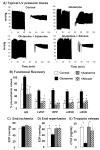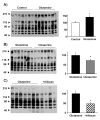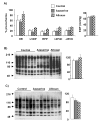Glutamine-induced protection of isolated rat heart from ischemia/reperfusion injury is mediated via the hexosamine biosynthesis pathway and increased protein O-GlcNAc levels - PubMed (original) (raw)
Glutamine-induced protection of isolated rat heart from ischemia/reperfusion injury is mediated via the hexosamine biosynthesis pathway and increased protein O-GlcNAc levels
Jia Liu et al. J Mol Cell Cardiol. 2007 Jan.
Abstract
It has been shown that glutamine protects the heart from ischemia/reperfusion (I/R) injury; however, the mechanisms underlying this protection have not been identified. Glutamine:fructose-6-phosphate amidotransferase (GFAT) regulates the entry of glucose into the hexosamine biosynthesis pathway (HBP), and activation of this pathway has been shown to be cardioprotective. Glutamine is required for metabolism of glucose via GFAT; therefore, the goal of this study was to determine whether glutamine cardioprotection could be attributed to increased flux through the HBP and elevated levels of O-linked N-acetylglucosamine (O-GlcNAc) on proteins. Hearts from male rats were isolated and perfused with Krebs-Henseliet buffer containing 5 mM glucose, and global, no-flow ischemia was induced for 20 min followed by 60 min of reperfusion. Thirty-minute pre-treatment with 2.5 mM glutamine significantly improved functional recovery (RPP: 15.6+/-5.7% vs. 59.4+/-6.1%; p<0.05) and decreased cardiac troponin I release (25.4+/-3.0 vs. 4.7+/-1.9 ng/ml; p<0.05) during reperfusion. This protection was associated with a significant increase in the levels of protein O-GlcNAc and ATP. Pre-treatment with 80 muM azaserine, an inhibitor of GFAT, completely reversed the protection seen with glutamine and prevented the increase in protein O-GlcNAc. O-GlcNAc transferase (OGT) catalyzes the formation of O-GlcNAc, and inhibition of OGT with 5 mM alloxan also reversed the protection associated with glutamine. These data support the hypothesis that in the ex vivo perfused heart glutamine cardioprotection is due, at least in part, to enhanced flux through the HBP and increased protein O-GlcNAc levels.
Figures
Figure 1
A) Typical left ventricular pressure (LVP) in hearts before and after 20 min global zero flow ischemia in control, untreated heart; heart treated with 2.5 mM glutamine 30 min prior to ischemia; heart treated with 80 μM azaserine 15 minutes before glutamine treatment; and heart treated with 5 mM alloxan 15 minutes before glutamine treatment; B) Functional recovery of heart rate (HR), left ventricular developed pressure (LVDP), rate-pressure product (RPP) and positive and negative rates of pressure change (± dP/dt) following 20 minutes ischemia and 60 minutes reperfusion as a % of pre-ischemic values; C) End diastolic pressure (EDP) at the end of ischemia; D) EDP at the end of reperfusion; E)Total cardiac troponin I (cTnI) release during reperfusion in control hearts (n=7), hearts perfused with 2.5 mM glutamine (n=7), 2.5 mM glutamine + 80 μM azaserine (n=7), and 2.5 mM glutamine + 5 mM alloxan (n=4). *= p<0.05 compared to glutamine group; ANOVA with Dunnett’s Multiple Comparison Test.
Figure 2
A) UDP-GlcNAc levels and B) ATP levels at the end of reperfusion in control hearts (n=7), hearts perfused with 2.5 mM glutamine (n=7), 2.5 mM glutamine + 80 μM azaserine (n=7), and 2.5 mM glutamine + 5 mM alloxan (n=4). *= p<0.05 compared to glutamine group; ANOVA with Dunnett’s Multiple Comparison Test.
Figure 3
Comparison of protein O-GlcNAc levels at the end of reperfusion in A) control hearts (n=7) and hearts perfused with 2.5 mM glutamine (n=7); B) hearts perfused with 2.5 mM glutamine and 2.5 mM glutamine + 80 μM azaserine (n=7), C) hearts perfused with 2.5 mM glutamine and 2.5 mM glutamine + 5 mM alloxan (n=4). On the left are CTD110 immunoblots of solubilized proteins from left ventricles of hearts and on the right are the mean intensities quantified by densitometric analysis of the immunoblots; in A) data are normalized to the mean intensities of control group in C) and D) data are normalized to the mean intensities of glutamine group; *= p<0.05, (unpaired Students T-Test).
Figure 4
A) Functional recovery of heart rate (HR), left ventricular developed pressure (LVDP), rate-pressure product (RPP) and positive and negative rates of pressure change (± dP/dt) following 20 minutes ischemia and 60 minutes reperfusion as a % of pre-ischemic values in untreated control hearts; hearts treated with 80μM azaserine (n= 4) or 5mM alloxan (n=4). Note that the control data are the same as that shown in Fig 1 and are shown here for comparison purposes only; B) Comparison of protein O-GlcNAc levels at the end of reperfusion in control hearts (n=7) and hearts treated with 80μM azaserine (n= 4) or 5mM alloxan (n=4); C) Comparison of protein O-GlcNAc levels following time-control normoxic perfusions in untreated control hearts (n=5) and hearts treated with 80μM azaserine (n= 4) or 5mM alloxan (n=4).
Figure 5
A) Functional recovery of heart rate (HR), left ventricular developed pressure (LVDP), rate-pressure product (RPP) and positive and negative rates of pressure change (±dP/dt) following 20 minutes ischemia and 60 minutes reperfusion as a % of pre-ischemic values in control hearts (CTL) (n=4), hearts perfused with 10 mM glucosamine (n=5), and hearts perfused with 10 mM glucosamine + 80 μM azaserine (n=4). B) End diastolic pressure (EDP) at the end of reperfusion. #= p<0.05 compared to control; ANOVA with Dunnett’s Multiple Comparison Test.
Similar articles
- Ischemic preconditioning increases myocardial O-GlcNAc glycosylation.
Vibjerg Jensen R, Johnsen J, Buus Kristiansen S, Zachara NE, Bøtker HE. Vibjerg Jensen R, et al. Scand Cardiovasc J. 2013 Jun;47(3):168-74. doi: 10.3109/14017431.2012.756984. Epub 2013 Jan 10. Scand Cardiovasc J. 2013. PMID: 23301939 - Increased hexosamine biosynthesis and protein O-GlcNAc levels associated with myocardial protection against calcium paradox and ischemia.
Liu J, Pang Y, Chang T, Bounelis P, Chatham JC, Marchase RB. Liu J, et al. J Mol Cell Cardiol. 2006 Feb;40(2):303-12. doi: 10.1016/j.yjmcc.2005.11.003. Epub 2005 Dec 9. J Mol Cell Cardiol. 2006. PMID: 16337959 - Glucosamine protects neonatal cardiomyocytes from ischemia-reperfusion injury via increased protein-associated O-GlcNAc.
Champattanachai V, Marchase RB, Chatham JC. Champattanachai V, et al. Am J Physiol Cell Physiol. 2007 Jan;292(1):C178-87. doi: 10.1152/ajpcell.00162.2006. Epub 2006 Aug 9. Am J Physiol Cell Physiol. 2007. PMID: 16899550 - Hexosamines, insulin resistance, and the complications of diabetes: current status.
Buse MG. Buse MG. Am J Physiol Endocrinol Metab. 2006 Jan;290(1):E1-E8. doi: 10.1152/ajpendo.00329.2005. Am J Physiol Endocrinol Metab. 2006. PMID: 16339923 Free PMC article. Review. - Hexosamine biosynthesis and protein O-glycosylation: the first line of defense against stress, ischemia, and trauma.
Chatham JC, Nöt LG, Fülöp N, Marchase RB. Chatham JC, et al. Shock. 2008 Apr;29(4):431-40. doi: 10.1097/shk.0b013e3181598bad. Shock. 2008. PMID: 17909453 Review.
Cited by
- How exercise may amend metabolic disturbances in diabetic cardiomyopathy.
Hafstad AD, Boardman N, Aasum E. Hafstad AD, et al. Antioxid Redox Signal. 2015 Jun 10;22(17):1587-605. doi: 10.1089/ars.2015.6304. Epub 2015 Apr 28. Antioxid Redox Signal. 2015. PMID: 25738326 Free PMC article. Review. - Effects of glycyl-glutamine dipeptide supplementation on myocardial damage and cardiac function in rats after severe burn injury.
Zhang Y, Yan H, Lv SG, Wang L, Liang GP, Wan QX, Peng X. Zhang Y, et al. Int J Clin Exp Pathol. 2013 Apr 15;6(5):821-30. Print 2013. Int J Clin Exp Pathol. 2013. PMID: 23638213 Free PMC article. - Substrate and product analogues as human O-GlcNAc transferase inhibitors.
Dorfmueller HC, Borodkin VS, Blair DE, Pathak S, Navratilova I, van Aalten DM. Dorfmueller HC, et al. Amino Acids. 2011 Mar;40(3):781-92. doi: 10.1007/s00726-010-0688-y. Epub 2010 Jul 17. Amino Acids. 2011. PMID: 20640461 Free PMC article. - Glucose Metabolism in Cardiac Hypertrophy and Heart Failure.
Tran DH, Wang ZV. Tran DH, et al. J Am Heart Assoc. 2019 Jun 18;8(12):e012673. doi: 10.1161/JAHA.119.012673. Epub 2019 Jun 12. J Am Heart Assoc. 2019. PMID: 31185774 Free PMC article. Review. No abstract available. - Cardiac metabolism and its interactions with contraction, growth, and survival of cardiomyocytes.
Kolwicz SC Jr, Purohit S, Tian R. Kolwicz SC Jr, et al. Circ Res. 2013 Aug 16;113(5):603-16. doi: 10.1161/CIRCRESAHA.113.302095. Circ Res. 2013. PMID: 23948585 Free PMC article. Review.
References
- Theroux P, Willerson JT, Armstrong PW. Progress in the treatment of acute coronary syndromes: a 50-year perspective (1950–2000) Circulation. 2000;102:IV2–IV13. - PubMed
- Heart Disease and Stroke Statistics: 2005 Update. American Heart Association; 2005.
- Khogali SE, Harper AA, Lyall JA, Rennie MJ. Effects of L-glutamine on post-ischaemic cardiac function: protection and rescue. J Mol Cell Cardiol. 1998;30:819–827. - PubMed
- Khogali SE, Pringle SD, Weryk BV, Rennie MJ. Is glutamine beneficial in ischemic heart disease? Nutrition. 2002;18:123–126. - PubMed
- Wischmeyer PE, Jayakar D, Williams U, Singleton KD, Riehm J, Bacha EA, Jeevanandam V, Christians U, Serkova N. Single dose of glutamine enhances myocardial tissue metabolism, glutathione content, and improves myocardial function after ischemia-reperfusion injury. JPEN J Parenter Enteral Nutr. 2003;27:396–403. - PubMed
Publication types
MeSH terms
Substances
Grants and funding
- R01 HL067464/HL/NHLBI NIH HHS/United States
- HL-077100/HL/NHLBI NIH HHS/United States
- HL-076165/HL/NHLBI NIH HHS/United States
- R01 HL076175/HL/NHLBI NIH HHS/United States
- R01 HL079364/HL/NHLBI NIH HHS/United States
- P50 HL077100/HL/NHLBI NIH HHS/United States
- HL-67464/HL/NHLBI NIH HHS/United States
- HL079364/HL/NHLBI NIH HHS/United States
LinkOut - more resources
Full Text Sources
Other Literature Sources
Research Materials
Miscellaneous




